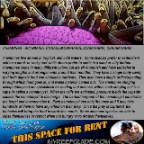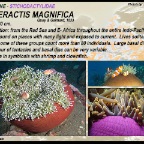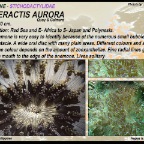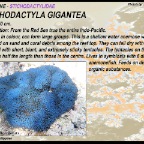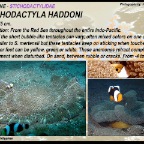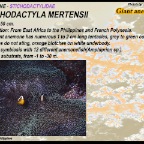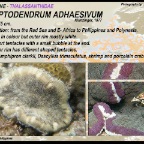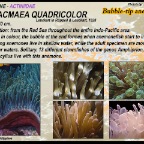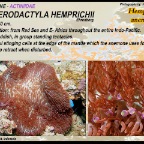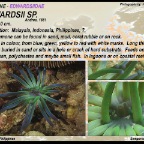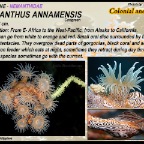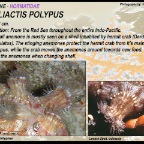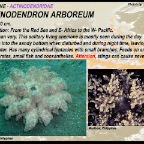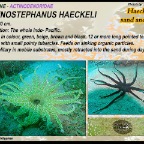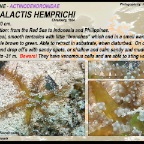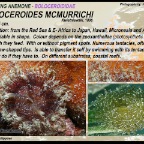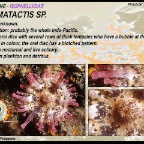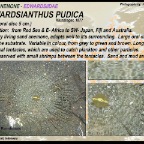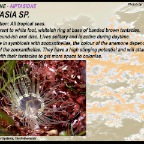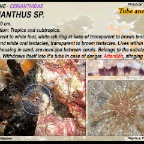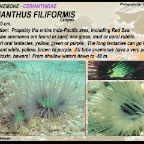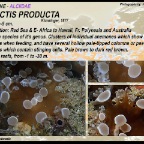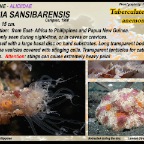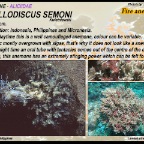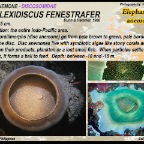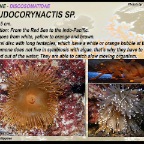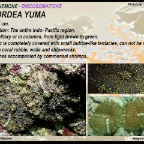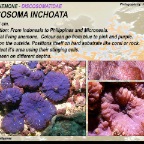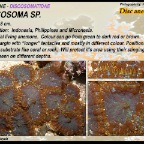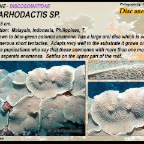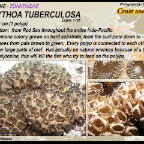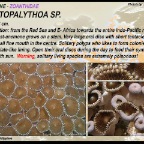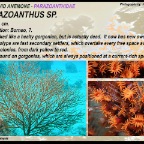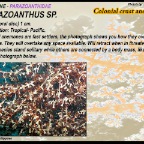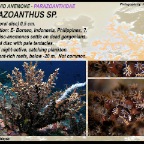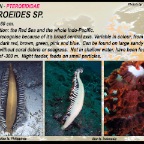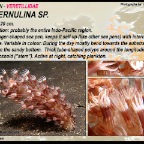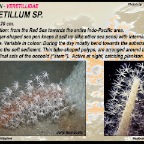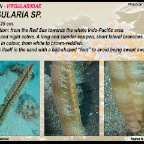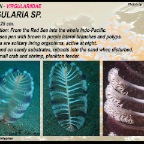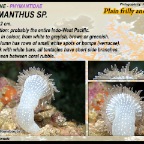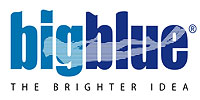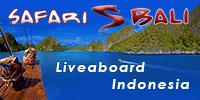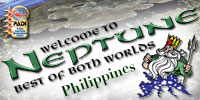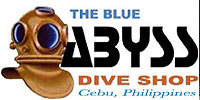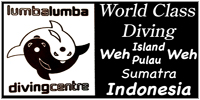Anemones & sea-pen
ANEMONES - ACTINIARIA, CORALLIMORPHARIA, ZOANTHARIA, CERIANTHARIA
Anemones live as well in tropical, and cold waters. Some species prefer to settle them self on a coral- or rocky reef while others prefer to settle in a sand or silty bottom. Anemones come in many different colors but are all round-ish and have tentacles in varying lengths and arrangements around their mouths. They have a single body cavity that both digests food and circulates nutrients. They also have a single orifice(opening) through which food goes in, and waste material comes out. The anemones stinging cells(cnidocytes) are specialized for feeding and defense, within each stinging cell is a capsule called a nematocyst. When the cells are activated, pressure inside the capsule causes the nematocyst to discharge. The barbed harpoon of the nematocyst penetrates the target and envenomates it. Each nematocyst can only fire once and it may take hundreds of them to have any effect on their prey. Once the prey is captured, the tentacles will bring the food towards the mouth. Some anemone species are able to close themselves or retract when not hungry or to protect themselves. Width: (oral disc) 0,5 cm.
Distribution: E- Borneo, Indonesia ?.
These disc-anemones settle on dead gorgonians. Dark oral disc with pale tentacles. Day and night-active, catching plankton. On current-rich reefs, below -20 m. Not common. Width: 20 cm.
Distribution: from the Red Sea to Indonesia and Philippines.
Cylindrical, smooth tentacles with little “branches” which end in a small warty ball.
From pale brown to green. Able to retract in substrate, when disturbed. On coral-rich
slopes and drop off’s with sandy spots, or shallow and calm sandy and muddy areas, from -9 to -31 m. Beware! They have venomous cells and are able to sting very hard. Width: 50 cm.
Distribution: from East- Africa to Japan and Papua New Guinea.
Variable in colour, from brown, grey, green and purple.
Often seen with white lines on tentacles and oral-disc.
Red to orange base. Retracts when disturbed. Sand areas of coastal reefs.
Width: (oral disc 5 cm.)
Distribution: from Red Sea & E- Africa to SW- Japan, Fiji and Australia.
A solitary living sand anemone, adapts well to it’s surrounding. Large oral disc, lies
flat on the substrate. Variable in colour, from grey to green and brown. Long, pointed,
cylindrical tentacles, which are used to catch plankton and other particles.
Often observed with small shrimps between the tentacles. Sand and mud areas.
Width: 75 cm.
Distribution: from the Red Sea and E- Africa to Philippines and Polynesia.
Very variable in colour but outer rim always in a different colour or tone. Very short
tentacles with a small bubble at the end. The outer rim has a ring with different
tentacles. Hosts, Amphipron clarkii, Dascyllus trimaculatus, shrimp and porcelain
crab. Attention! This anemone has a enormous stinging power. Width: 10 cm.
Distribution: Malaysia, Indonesia, Philippines, ?.
This anemone can be found in sand, mud, coral rubble or on rock.
Long bluish with green tentacles, blue oral disc. Uses basal disc to attach itself to
rock or hold itself in soft substrate. Feeds on polychaetes, small crustacean and
maybe small fish. In lagoons or on coastal reefs. Width: 3 cm. within the white bordered area.
Distribution: Philippines, Indonesia, ?
Nocturnal, long pink translucent tentacles, oral tentacles are shorter.
White border at one cm. around the mouth. During the day inside it’s tube.
Width: 20 cm.
Distribution: propably the entire Indo-Pacific area, including Red Sea.
These tube anemones are found in sand, sea grass, mud or coral rubble.
The short oral tentacles, yellow, green or purple. The long tentacles can go from
translucent white, yellow, brown to purple. All tube anemones have a very potent
nettling toxin, beware! From shallow waters down to -50 m. Length: 20 cm.
Distribution: probably the entire Indo-Pacific region.
Thick finger-shaped sea pen, keeps it self up (like other sea pens) with internal water
pressure. Variable in colour. During the day mostly bend towards the substrate or
hidden in the sandy bottom. Thick tube-shaped polyps around the longitudinal axis
of the oozooid (”stem”). Active at night, catching plankton. Width: 5 cm.
Distribution: from the Red Sea & E- Africa to Japan, Hawaii, Micronesia and Australia.
Very variable in shape. Colour depends on the zooxanthellae (photosynthetic algae), on which they feed. With or without pigment spots. Numerous tentacles, often with corkscrew-shaped tips. Is able to transfer it self by swimming with its tentacles, but will only do if they have to. On different substrates, coastal reefs.
Length: 15 cm.
Distribution: from East- Africa to Philippines and Papua New Guinea.
Mostly only seen during night-time, or in caves or crevices.
Holds itself with a large basal disc on hard substrates. Long transparent body with
grape-like vesicles covered with stinging cells. Transparent tentacles for catching
plankton. Attention: stings can cause extreme heavy pain!
Length: 25 cm.
Distribution: from the Red Sea towards the whole Indo-Pacific area.
Solitary and night active. A long and slender sea pen, short lateral branches.
Variable in colour, from white to brown-reddish.
Anchors itself in the sand with a ball-shaped “foot” to avoid being swept away by the current. Length: 25 cm.
Distribution: from the Red Sea into the whole Indo-Pacific.
A white sea pen with brown to purple lateral branches and polyps.
Sea pens are solitary living organisms, active at night.
Only found on sandy substrates, retracts into the sand when disturbed.
Hosts small crab and shrimp, plankton feeder. Length: 20 cm.
Distribution: from the Red Sea towards the entire Indo-Pacific area.
This finger-shaped sea pen keeps it self up (like other sea pens) with internal water
pressure. Variable in colour. During the day mostly bend towards the substrate or
hidden in the soft sediment. Thin tube-shaped polyps, are arranged around the
Width: variable.
Distribution: probably the whole Indo-Pacific.
A large oral disc with several rows of thick tentacles, these tentacles have a bubble
at the end. Variable in colour, the oral disc has a blotched pattern.
They are nocturnal and live solitary. Feeds on plankton and detritus. axis of the oozooid (”stem”). Active at night, catching plankton. Width: 150 cm.
Distribution: from East Africa to the Philippines and French Polynesia.
This giant anemone has numerous 1 to 2 cm long tentacles, grey to green colour.
Tentacles do not sting, orange blotches on white underbody.
Lives in symbiosis with 12 different anemonefish(Amphiprion sp.).
On hard substrate, from -1 to -30 m. Width: 75 cm.
Distribution: from the Red Sea throughout the entire Indo-Pacific.
Color of the short bubble-like tentacles can vary, often mixed colors on one anemone. Very similar to S. mertensii but these tentacles keep on sticking when touched. The column or foot can be yellow, green or white. These anemones retract completely into the sediment when disturbed. On sand, between rubble or cracks. From -4 to -40 m. Width: 50 cm.
Distribution: from the Red Sea throughout the entire Indo-Pacific.
Variable in colour, can form large groups. This is a shallow water anemone which can be found on sand and coral debris among the reef top. They can fall dry with low tide. Covered with short, blunt, and extremely sticky tentacles. The tentacles on the outer edge are half the length than those in the centre. Lives in symbiosis with 6 different anemonefish. Feeds on dissolved organic substances. Width: 7 cm.
Distribution: the entire Indo- Pacific region.
Lives solitary or in colonies, from light brown to green.
Oral disc is completely covered with small bubble-like tentacles, can not be retracted. Lives on coral rubble, walls and shipwrecks.
Sometimes accompanied by commensal shrimps. Length: 60 cm.
Distribution: the Red Sea and the whole Indo-Pacific.
Easy to recognise with it’s broad central axis. Variable in colour, from yellow to
orange, brown, green, pink and blue. This sea pen can be found on large sandy areas with or without coral debris or seagrass. Not in shallow water, they have been found to -300 m. They feed on small particles, night feeder. Width: 15 cm.
Distribution: from the Red Sea throughout the entire Indo-Pacific area.
Colour goes from white, yellow to orange and brown.
Large oral disc with long tentacles, which have a white or orange bubble at the end. This anemone does not live in symbiosis with algae, that’s why they have to catch their food out of the water; They are able to catch slow moving organism.
Width: 3 cm.
Distribution: from the Red Sea and E- Africa towards the entire Indo-Pacific region.
This crust-anemone grows on a stem. Very large oral disc with short tentacles at the end. Small fine mouth in the centre. Solitary polyps who likes to form colonies.
Radial plate-like lining. Open their oral discs during the day to feed their symbiotic
algae with sun. Warning, solitary living species are extremely poisonous!
Width: cm.
Distribution: Indonesia, Philippines and Micronesia.
During daytime this is a well camouflaged anemone, colour can be variable.
Oral disc mostly overgrown with algae, that’s why it does not look like a anemone.
During night time an oral tube with tentacles comes out of the centre of the oral disc. Warning, this anemone has an extremely stinging power which can be felt for weeks. Width: 1 cm.
Distribution: Borneo, ?.
This looked like a healty gorgonian, but is actually dead. It now has new owners.
These polyps are fast secondary settlers, which overtake every free space available. Forms colonies, from dark yellow to red.
Mostly found on gorgonias, which are always positioned at a current-rich spot.
Width: 2 cm.(1 polyp)
Distribution: from Red Sea throughout the entire Indo-Pacific.
This anemone colony grows on hard substrate, from the surf-zone down to -15 m.
Colour goes from pale brown to green. Every polyp is connected to each other and
can cover large parts of reef. Has actually no natural enemies because of a toxin
called palytoxine, this will kill the fish who try to feed on the polyps. Width: 8 cm.
Distribution: from E- Africa to the West-Pacific, from Alaska to California.
Colour can go from white to orange and red. Small oral disc surrounded by fine
pointed tentacles. They overgrow dead parts of gorgonias, black coral and sea whips. A plankton feeder which eats at night, sometimes they retract during day time. Solitary species sometimes go with the current. Width: 18 cm.
Distribution: Malaysia, Indonesia, Philippines, ?.
Grey-brown to blue-green colonial anemone, has a large oral disc which is covered with numerous short tentacles. Adapts very well to the substrate it grows on. There are puplications who say that these anemones with more than one mouth split into two seperate anemones. Settles on the upper part of the reef.
Width: 50 cm.
Distribution: from W- Africa to Japan, Philippines and Indonesia.
Variable in colour, this depents on the symbiotic algae around the anemone, purple, grey, brown and green. A solitary living anemone who is partly burried into the sub strate, retracts into the sand when disturbed. Tentacles max. 18 cm long.
Feeds on crabs and small fish. Coastal areas. Width: 40 cm.
Distribution: the Red Sea and E- Africa, the entire Indo-Pacific down to Polynesia.
Small reddish in group standing tentacles.
Small colourful stinging cells at the edge of the mantle which the anemone uses for
defence. Is able to retract when disturbed. Width: 60 cm.
Distribution: from the Red Sea and E- Africa to the Indo-Pacific and Samoa.
This anemone is mostly found on places with a lot of light and exposed to current.
Lives solitary or in group, some of these groups count more than 80 individuals.
Large basal disc(foot). The colour of tentacles and basal disc can be very variable.
Sometimes the anemone closes so only a few tentacles come out. They live in sym-
biosis with shrimp and clownfish. Width: 30 cm.
Distribution: Red Sea and E- Africa to S- Japan and Polynesia.
This anemone is very easy to identify because of the numerous small bubbles on
each tentacle. A wide oral disc with many plain areas. Different colours and appearance. The colour depends on the amount of zooxanthellae. Fine radial lines going from the mouth to the edge of the anemone. Lives solitary. Width: 70 cm.
Distribution: from the Red Sea throughout the entire Indo-Pacific area.
The bubble at the end formes when anemonefish start to live in it. Different colours.
The young anemones live in shallow water, sometimes with many together. While the adult species are mostly found in deeper waters, living solitary. 13 different clown fishes of the genus Amphiprion, Premnas and Dascyllus live with this anemone. Width: 18 cm.
Distribution: Indonesia, Philippines and Micronesia.
A colonial living anemone. Colour can go from green to dark red or brown.
Outer margin with “longer” tentacles and mostly in different colour. Positions itself
on hard substrate like coral or rock. Will protect it’s area using their stinging cells.
Can be seen on different depths. Width: 8 cm.
Distribution: from Indonesia to Philippines and Micronesia.
A colonial living anemone. Colour can go from blue to pink and purple.
Ribbed on the outside. Positions itself on hard substrate like coral or rock.
Width: 20 cm.
Distribution: tropics and subtropics.
Transparent to white foot, white-ish ring at base of transparent to brown tentacles.
Brown and white oral tentacles, transparent to brown tentacles. Lives within their
tubular housing in sand, crevices and between corals. Belongs to the subclass Hexa-corrallia. Withdraws itself into it’s tube in case of danger. Attention, stinging cells! protect it’s area using their stinging cells. Can be seen on different depths.
Width: 2 cm.
Distribution: from the Red Sea throughout the entire Indo-Pacific.
This small anemone is mostly seen on a shell inhabited by hermit crab (Dardanus
pedunculatus). The stinging anemones protect the hermit crab from it’s main predator the octopus, while the crab moves the anemones around towards new food. The crabs transfer the anemones when changing shell.
Width: 45 cm.
Distribution: the entire Indo-Pacific area.
These large corallimorphs (disc anemone) go from pale brown to green, whitish
border at the end of the disc. They stick themselves to solid rock on sheltered areas.
Disc anemones live with symbiotic algae and feed mainly on their products, plankton or a lost small fish. When particles settle on the oral disc, it forms a ball to feed. Depth: between -10 and -15 m. Distribution: all tropical seas.
Transparent to white foot, whiteish ring at base of banded brown tentacles.
Flat to round-ish oral disc. Lives solitary and is active during daytime.
They live in symbiosis with zooxanthellae, the colour of the anemone depends on the colour of the zooxanthellae. They have a high stinging potential and will attack other corals with their tentacles to get more space to colonise. Width: 60 cm.
Distribution: the whole Indo- Pacific area.
Variable in colour, green, beige, brown and black. 12 or more long pointed tentacles covered with small pointy tubercles. Feeds on sinking organic particles.
Lives solitary in mobile substrates, mostly retracted into the sand during day time.
Width: 30 cm.
Distribution: from the Red Sea and E- Africa to the W- Pacific.
Colour can vary. This solitary living anemone is mostly seen during the day.
Retracts into the sandy bottom when disturbed and during night time, leaving a small deep crater. Has many cylindrical tentacles with small branches. Feeds on small invertebrates, small fish and zooxanthellae. Attention, stings can cause severe pain!


